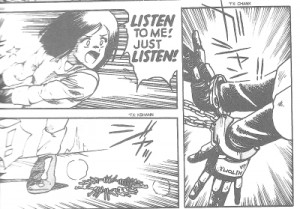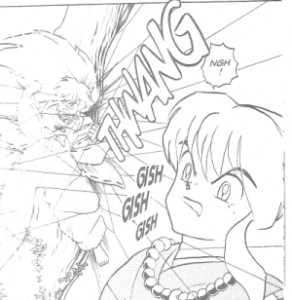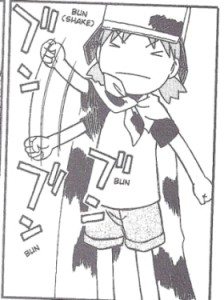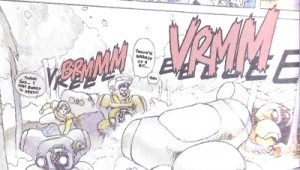There’s something that’s been bugging me lately, and it has to do with sound effects (onomatopoeia) in manga that has been translated for an English-speaking audience.

Because different languages use different words for the same sounds (e.g., in English “ribbit ribbit” as opposed to Japanese “gerro gerro”) when it comes time to translate manga that has sound effects (and I can’t think of a manga that doesn’t use sound effects) there are several different ways to approach the task.
One way is to leave the Japanese sound effects as-is in the manga, and simply add notes in the margins. These sound effects (or “SFX”) notes might say “SFX: clink” or they might say “SFX: kasha (clink).” The latter simply transcribes the sound, and then provides a translation in parenthesis. (Later occurrences of that same sound effect may not be translated, or may simply appear as “kasha” in the margin without the translation.) More difficult sound effects might simply be written out as what they are describing, e.g., “SFX: sound of chair scooting back.”
Another approach is to write these same types of translations as above, but put them in-panel, right near the original Japanese sound effect word. This is a little bit easier to read (you don’t have to keep looking in the margins), but it still feels a little awkward.
Yet another approach (and probably the one I prefer) is to simply write the English-equivalent sound effect word on or near the original Japanese word right in-panel, without prefixing it with “SFX” and without transcribing what the original Japanese would have been if written out phonetically in English. For example, if a door is being locked, instead of writing “SFX: gachan (door locking),” just write what an English-speaking person would expect to see in the same circumstance – in other words, just write “click!”

A final approach is to erase the original Japanese sound effects and replace them with English words completely. This is easy for some sound effects that are little and kind of to the side of a panel in some white space… but can be very difficult when the sound effect word is written almost as part of the background.

Personally, I prefer the method of simply writing the English equivalent sound effect right there (without the SFX note or a transliterated version of what the Japanese word is), along with the occasional total replacement (where it is really easy to do).

This has recently been bothering me because I’ve been reading Yotsuba (sorry, “Yotsuba&!“) lately, and the publisher changed hands not too long ago when ADV stopped doing manga. (It is now published by Yen Press, who also publishes The Melancholy of Haruhi Suzumiya.) It bothers me because I really liked the way ADV did their manga translations – they used the method I prefer, and they also often had “translator’s notes” at the end of the book so you could get that more in-depth explanation for circumstances where the translation was difficult or where changes had to be made for space/cultural reasons. This made sure that the “flow” of the manga wasn’t constantly interrupted.

Yen Press tends to use the second method I described above – the one where they write the transliterated word first, then the English equivalent in parenthesis (and don’t repeat the English translated word after that). I don’t like this, because I’m used to English sound effect words, and I haven’t gotten used to all the Japanese equivalents yet. And since I’m reading the manga translated into English, I kind of prefer my sound effects to be in English as well.

Interestingly, I’ve seen both methods used by manga published by Dark Horse Comics, while ADV (when they were still in business) and Bandai tend to use the translation style I prefer. And on the far end of the scale, Viz seems to use the “total replacement with English words” approach.
I’m also not sure why some companies tend to do their translated sound effects one way or the other. Perhaps it has to do with the size of their translation staff, or the personal preference of someone in charge of the translation department. Perhaps it’s even dictated by what the company’s customers have requested.
Naturally, not everyone is going to agree with me here – some people might like to know the Japanese sound effect word, for example, or some people might prefer the “in the margins” approach because it’s easier for the publisher and allows them to translate manga titles faster.
Still, I think it’s important to pay attention to the way sound effects are written – done well, they let you read the story with the same ease you might read an English language (or whatever your native language is) comic. Done less well and they can interrupt your reading, or make it difficult to follow the action, or just plain spoil the “feel” of the story.
I just feel that the translation of sound effects deserves the same care and attention given to the main text. But then again, nobody said translating (or, more accurately, “localizing”) manga was going to be easy!